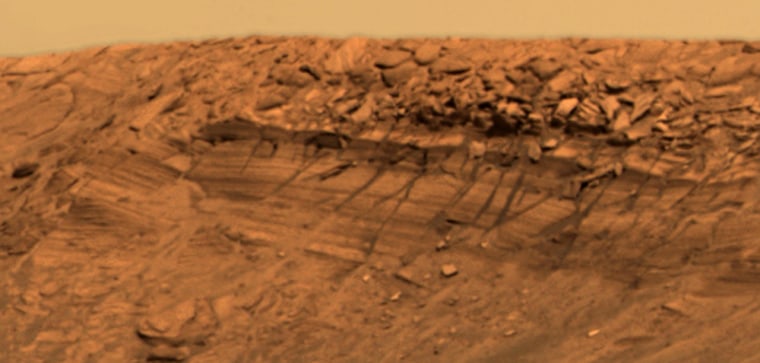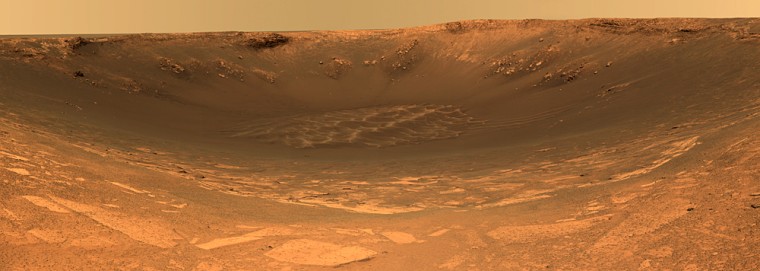NASA's Mars rover Opportunity will have to watch its step around its Endurance Crater destination to avoid a potentially mission-ending fall, while its twin Spirit continues its approach to the Columbia Hills.
Rover mission scientists are particularly wary about sending Opportunity into Endurance crater, which bears tempting rock outcrops for study but could be catastrophic if the rover slips. With a depth of more than 66 feet (20 meters), Endurance is 10 times deeper than Eagle Crater, where Opportunity came to rest more than three months ago.
"This is a big hole in the ground," said Cornell University's Steve Squyres, the rover project's principal investigator, during a mission briefing held Thursday at NASA's Jet Propulsion Laboratory. "There are cliffs where the rover could fall off and die if we're not careful."
Rover researchers have long anticipated Opportunity's arrival at Endurance, which spans about 430 feet (130 meters), hoping to find a rock outcrop similar to the one at the rover's Eagle Crater landing site to give them a better sense of the geologic history of the planet.
It seems they've found that in the form of Burns Cliff, a massive outcrop along the ridge of Endurance Crater and Opportunity's most likely point of attack into the rocky past of its Meridiani Planum landing site. The cliff stands yards high, well above the foot-high outcrop studied so eagerly at Eagle Crater. Studying the cliff close-up would give scientists a deeper look into the Martian surface.
"These are much bigger than anything we've seen before of layered rocks on Mars," Squyres said during a mission briefing. "That is going to tell us much of what is going to happen at Meridiani Planum."
While there is ample suggestion of crossbedding in the cliff and a healthy scattering of hematite-rich spherules across the crater, mission scientists aren't sure what Burns Cliff may tell them about the history of Martian water.
Squyres said Opportunity's remote sensing instruments indicate the cliff is mostly basalt, a type of rock that makes up most of the seafloor on Earth. But whether that means the rock is solely sandstone or was once a Martian beach or sand dune remains to be determined, he added.
First, the rover has to find a safe way into the crater, and mission planners are working to find the safest route into Endurance.
Brian Cooper, rover planning team leader at JPL, said the slope along the walls of Endurance ranges from 18 degrees to 20 degrees. Physically, Opportunity is built to withstand a slope of 35 degrees, but its onboard software sets a 20-degree limit in case the robot slips on loose soil.

While mission planners determine the best route into Endurance, Opportunity will take a slow trip around the crater's lip, taking images with its cameras and making a detailed analysis of the region.
Should there be any hint of danger in any entry plan, Opportunity will first study other science targets on the Meridiani Planum plains before descending into the crater.
"We're not done with science on the plains yet," Squyres said, adding that the heat shield shed by Opportunity during its January landing is nearby, and follow-up studies of recent targets like Fram Crater and the Anatolia outcrop would be useful.
Meanwhile, Opportunity's robotic twin Spirit is planning its approach to the Columbia Hills. The rover is almost to the midway point of its trip from Bonneville Crater to the hills, where it will roll up to the most accessible of the seven geologic features.
"Not all of the hills are going to be accessible to this rover," said Amy Knudson, a rover science team collaborator from Arizona State University. She said some of the hills will still be too distant. "But we're hoping we'll find our own Endurance Crater."
